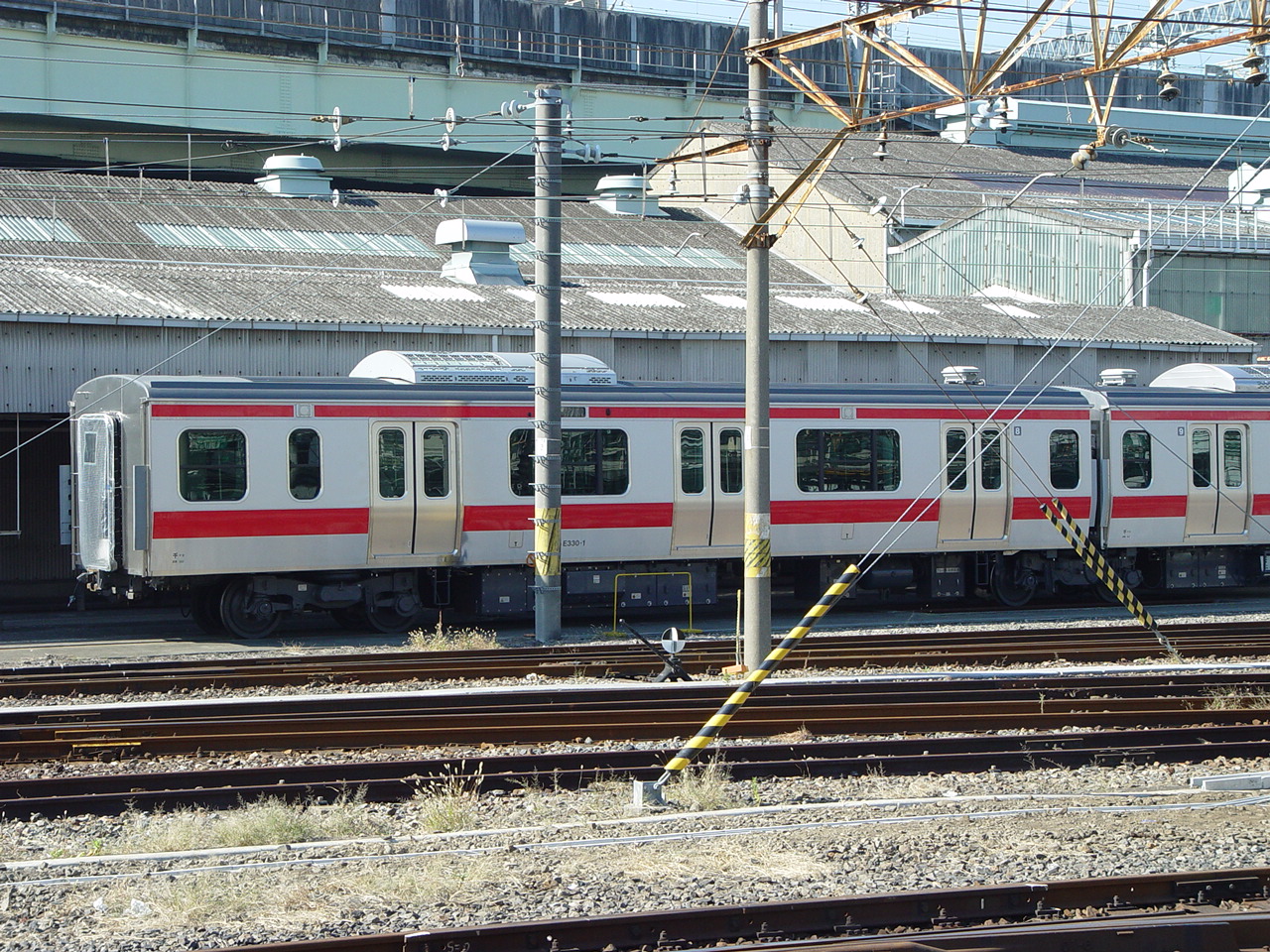E331 series on:
[Wikipedia]
[Google]
[Amazon]
The was an
File:E331 TR257 car 8 Kunitachi 20140325.JPG, TR257 trailer bogie
File:E331 TR258 Kunitachi 20140325.JPG, TR258 shared trailer bogie
File:E331 DT73 Kunitachi 20140325.JPG, DT73 shared motor bogie
 * Cars 3 and 10 (SaHa E331-502 and SaHa E331-501) were each fitted with one PS37 single-arm
* Cars 3 and 10 (SaHa E331-502 and SaHa E331-501) were each fitted with one PS37 single-arm
File:E331 interior 20070318 (1).jpg, General interior view
File:E331 interior 20070318 (2).jpg, 5-person bench seat
File:L25 TcE330-seat.jpg, Transverse seating bay in car 1
File:E331-VIS.JPG, LCD passenger information display
File:E331 cars 1-7 Yamate 20060309.JPG, Cars 1 to 7 on delivery from Tokyu Car's Yokohama factory, March 2006
File:E331 Keiyo Line 20100627.jpg, The E331 series set in service on the Keiyo Line, June 2010
File:E331 Platform Sign.jpg, A sticker on the Keiyo Line platform at Tokyo Station marking the door position for E331 series trains, April 2008
File:E331 AK1 Kunitachi 20140325.JPG, The E331 series set being hauled to JR East's Nagano Works in March 2014
JR East E331 series
(Japan Railfan Magazine Online) {{JR East EMU Electric multiple units of Japan East Japan Railway Company Train-related introductions in 2007 Articulated passenger trains Experimental vehicles Tokyu Car multiple units Kawasaki multiple units 1500 V DC multiple units of Japan
electric multiple unit
An electric multiple unit or EMU is a multiple-unit train consisting of self-propelled carriages using electricity as the motive power. An EMU requires no separate locomotive, as electric traction motors are incorporated within one or a number o ...
(EMU) train introduced experimentally from 2007 on commuter services on the Keiyo Line in Japan operated by East Japan Railway Company
The is a major passenger railway company in Japan and the largest of the seven Japan Railways Group companies. The company name is officially abbreviated as JR-EAST or JR East in English, and as in Japanese. The company's headquarters are in ...
(JR East). Only one trainset was built, and it differed significantly from other JR commuter EMUs in having articulated cars with shared bogies and using direct-drive motors.
Bogies
The 14-car set was mounted on a total of 16bogie
A bogie ( ) (or truck in North American English) comprises two or more Wheelset (rail transport), wheelsets (two Railroad wheel, wheels on an axle), in a frame, attached under a vehicle by a pivot. Bogies take various forms in various modes ...
s: four TR257 trailer bogies (cars 1, 7, 8, 14), six TR258 shared trailer bogies, and six DT73 shared motor bogies.
Formation
The lone set, AK1, consisted of two 7-car half-sets, and is formed as follows, with car 1 at the Tokyo end.pantograph
A pantograph (, from their original use for copying writing) is a Linkage (mechanical), mechanical linkage connected in a manner based on parallelograms so that the movement of one pen, in tracing an image, produces identical movements in a se ...
.
* Cars 1 and 14 seated 36 when the seats are configured in transverse mode.
Interior
Cars 2 to 13 had longitudinal seating, while the end cars 1 and 14 had transverse seating bays which could be rotated and rearranged longitudinally against the train sides to provide increased standing space during peak hours.History
Incorporating new technology tested on the earlier experimental E993 series "AC Train", the E331 series was delivered to JR East in March 2006. Cars 1 to 7 were built byTokyu Car Corporation
is a manufacturer of heavy rail cars in Japan, formerly known as . The company is based in Kanazawa-ku, Yokohama, and a member of East Japan Railway Company (JR East) group. J-TREC manufactures rail vehicles not only for JR East and Tokyu Corpo ...
in Yokohama
is the List of cities in Japan, second-largest city in Japan by population as well as by area, and the country's most populous Municipalities of Japan, municipality. It is the capital and most populous city in Kanagawa Prefecture, with a popu ...
, and cars 8 to 14 were built by Kawasaki Heavy Industries
is a Japanese Public company, public multinational corporation manufacturer of motorcycles, engines, Heavy equipment (construction), heavy equipment, aerospace and Military, defense equipment, rolling stock and ships, headquartered in Minato, To ...
in Kobe
Kobe ( ; , ), officially , is the capital city of Hyōgo Prefecture, Japan. With a population of around 1.5 million, Kobe is Japan's List of Japanese cities by population, seventh-largest city and the third-largest port city after Port of Toky ...
.
Following extensive test running, the set entered revenue service on the Keiyo Line between Tokyo and from the start of the revised timetable on 18 March 2007, used only on weekend services. From April, the set was taken out of service, and in October 2007, the seven Kawasaki-built cars were returned to their manufacturer for modifications, and in March 2008, the seven Tokyu Car cars were also returned to Tokyu Car for modifications. The set was returned to service on 23 December 2008.
The set was removed from revenue service in May 2009, returning to service on 3 April 2010. It was subsequently removed from service again, and remained stored out of service at Shin-Narashino Depot from early 2011 before finally being hauled to Nagano Works in March 2014 for scrapping.
See also
* E231 series *E233 series
The is a commuter and suburban electric multiple unit (EMU) train type developed by East Japan Railway Company (JR East) from the earlier E231 series and the E531 series design. The first train was introduced in December 2006 for use on the Ch� ...
References
Further reading
*External links
* (JR East)JR East E331 series
(Japan Railfan Magazine Online) {{JR East EMU Electric multiple units of Japan East Japan Railway Company Train-related introductions in 2007 Articulated passenger trains Experimental vehicles Tokyu Car multiple units Kawasaki multiple units 1500 V DC multiple units of Japan